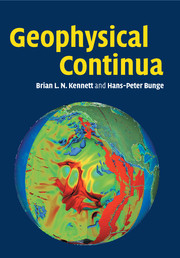Book contents
- Frontmatter
- Contents
- Preface
- 1 Introduction
- PART I CONTINUUM MECHANICS IN GEOPHYSICS
- 2 Description of Deformation
- 3 The Stress-Field Concept
- 4 Constitutive Relations
- 5 Linearised Elasticity and Viscoelasticity
- 6 Continua under Pressure
- 7 Fluid Flow
- 8 Continuum Equations and Boundary Conditions
- PART II EARTH DEFORMATION
- Appendix: Table of Notation
- Bibliography
- Index
6 - Continua under Pressure
from PART I - CONTINUUM MECHANICS IN GEOPHYSICS
Published online by Cambridge University Press: 17 March 2011
- Frontmatter
- Contents
- Preface
- 1 Introduction
- PART I CONTINUUM MECHANICS IN GEOPHYSICS
- 2 Description of Deformation
- 3 The Stress-Field Concept
- 4 Constitutive Relations
- 5 Linearised Elasticity and Viscoelasticity
- 6 Continua under Pressure
- 7 Fluid Flow
- 8 Continuum Equations and Boundary Conditions
- PART II EARTH DEFORMATION
- Appendix: Table of Notation
- Bibliography
- Index
Summary
The linearised development of elasticity in the previous chapter can be applied about a stress-free state and has therefore direct application to the shallower parts of the Earth. As we shall see, we can make an incremental treatment about the stress-state at depth, which will be dominantly hydrostatic, and derive the incremental elastic moduli for small disturbances such as those created by the passage of seismic waves.
It is difficult in experimental studies to achieve the pressures and temperatures appropriate to a direct study of the Earth. For the lower mantle, in particular, recourse needs to be made to extrapolation from available conditions. A convenient summary of the property of Earth materials at depth is provided by the equation of state, which is commonly expressed as a relation between the pressure, the specific volume and the temperature. This simplified approach ignores non-hydrostatic stresses and any non-isotropic response to the assumed hydrostatic pressure. Finite strain representations are used in the Birch–Murnaghan equations to relate the conditions at depths to the properties at zero pressure.
Long-term response to large non-hydrostatic stresses leads to irreversible (plastic) deformation, and so over geological time materials are expected to have yielded to such stresses, leaving just the hydrostatic load at depth. Non-hydrostatic stresses are, however, important at shallow depth where they approach the magnitude of the pressure and are responsible for the occurrence of earthquakes.
- Type
- Chapter
- Information
- Geophysical ContinuaDeformation in the Earth's Interior, pp. 95 - 109Publisher: Cambridge University PressPrint publication year: 2008



